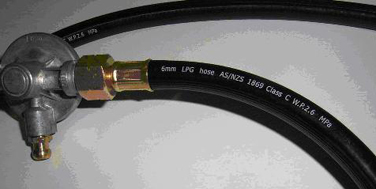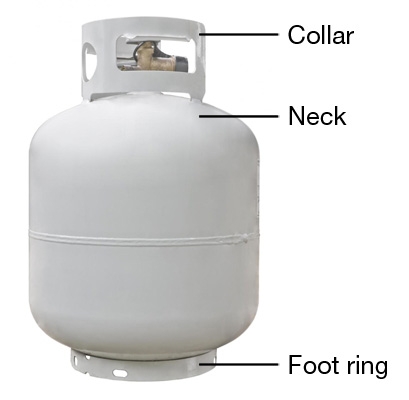LPG cylinders store LPG as a liquid. It's then released as a vapour into your gas appliance to burn. Make sure you check that your cylinder (and fittings) is safe before you use it.
Cylinders need to be safety tested or replaced every 10 years.
LCC27 valves
The connection fittings on LPG gas cylinders for BBQs and other outdoor appliances changed in 2021.
You won’t need to alter existing appliances or buy adaptors. LCC27 cylinder fittings are designed to connect to both the LCC27 and POL fittings.
Compatible
- LCC27 cylinder to LCC27 appliance
- LCC27 cylinder to POL appliance
- POL cylinder to POL appliance
Not compatible
POL cylinder to LCC27 applianceVisit the Gas Energy Australia website to find out more about the change to LCC27 fittings.
Safety testing
By law, portable cylinders can only be refilled if they have a valid ten-year stamp on the collar, neck or foot ring. The stamp will have the letter T followed by the month and year.
If the stamp is out of date, the cylinder must be tested at an authorised test station or swapped for a newer cylinder.
Hoses and regulators should also be certified to Australian Standards and have a certification number printed on them from recognised certifying body. Hoses should be replaced every five years.

Safe storage and use
Storing LPG cylinders
- Store upright and a well ventilated outdoor area.
- Protect cylinders from excess heat and anything that might cause them to ignite.
- Put a sealing plug in the cylinder valve when it's not connected to the appliance.
Using LPG cylinders
- Use LPG cylinders with LPG appliances – it’s unsafe to use them with appliances designed for natural gas.
- Check for leaks.
- Never tamper with or apply force to the safety valve or fittings.
- Shut off the cylinder valve before disconnecting the cylinder.
- Turn the appliance off when replacing a portable cylinder.
- Dew lines around the cylinder when an appliance is running are common and not dangerous.
- Ice build-up indicates more gas is needed than the cylinder can provide – refill or replace with a larger cylinder.
- If you are replacing one cylinder from a pair in a permanent installation, turn off all LPG appliances, unless an automatic changeover valve is fitted.
Filling LPG cylinders
Most retailers will swap empty cylinders for full ones. This can ensure the cylinder is within the ten-year certification and has been filled correctly.
Never fill portable LPG cylinders from Autogas dispensers – this is illegal and dangerous. Australian LPG appliances are designed only for use with commercial LPG.
The maximum fill for portable cylinders is 80%. This allows for heat expansion. The empty weight is stamped on the cylinder so the amount of gas left can be estimated. Some cylinders have a contents gauge fitted.
Transporting cylinders
When transporting an LPG cylinder:
- secure it in an upright position
- use a sealing plug to prevent gas leakage
- keep the cylinder cool
- don't carry it in the passenger space.
Don’t keep LPG cylinders in your car, especially in hot weather. If the cylinder overheats, the safety relief valve will release and fill the car with vapour.
If you must transport a portable cylinder during hot weather, secure it upright and wrap it in a wet towel.
Damage, rust and safe disposal
LPG cylinders should be inspected at an authorised test station if they have:
- been affected by fire or heat
- rust
- been damaged.
Old cylinders must be disposed of through an authorised test station, LPG supplier or filler – never through household rubbish collection or at the dump.
Visit Which Bin or contact your local council to find your closest hazardous waste drop-off centre.


